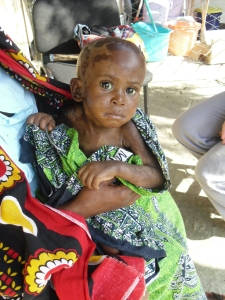Teddy’s story
Mid-2011 there were terrible images from North-eastern Kenya of badly malnourished children. At that time, 1 out of every 2 children admitted at the Kilifi District Hospital were either moderately or severely malnourished. So I wrote a story about this……obviously the papers had had enough of it and did not want to publish yet another story. As I interviewed Teddy’s mother, I was moved by her helplessness, her guilt, the poor state of her son. I did my best not to cry in her presence but I did have a long weep later. Here is Teddy as he looked then and this was his story.

Little Teddy is 15 months old and weighs a meagre 5.5 Kg, the average weight of a 3 to 4 month infant. His skin is dry and peeling. He has the dry-mouthed, wide-eyed vacant stare, familiar in images from Dadaab and Turkana (North-eastern Kenya). But Teddy, who has never left Kilifi, was admitted in August at the Kilifi District Hospital, severely malnourished. Malnutrition is clearly not just a problem of the Northern regions.
Teddy who was suffering from diarrhoea, fever and a blood-stream infection made good progress. The clinicians attending to him were impressed by his tenacity. Although he was on the extreme end of the malnutrition spectrum, he is not alone. Out of every 2 children admitted at the Kilifi District hospital, one will be moderately to severely malnourished.
There is a vicious cycle in play between severity of infection and malnutrition, explains a senior consultant paediatrician at the Kilifi District Hospital who is also a malnutrition expert, Dr James Berkley. ‘When a child is malnourished, their immune system is greatly compromised and they easily catch infections and fall ill. In turn, these infections use up energy and cause them to eat less, exacerbating the child’s nutritional status and so leading to even more disease. Death rates among seriously malnourished children are 5 to 10 times that of children in good health when exposed to the same infection,’ Dr Berkley said.
Teddy’s mother says his pregnancy was her worst. ‘My husband left me while I was pregnant. My head was full of worries. I did not eat well and I was often sick. With the other four pregnancies, I was huge but not with Teddy. I thought he would weigh 1 Kg when he was born,’ Teddy’s mother said.
A look at Teddy’s growth chart shows that he was born underweight, he did not put on as much weight as he should have and when his mother left him with his grandmother to look for work, the drop in weight was dramatic. Teddy’s mother was forced to work as a gardener to raise money for all her 5 children. As a single mother, earning little, she left her child with her mother. The child soon stopped breastfeeding and when he got diarrhoea, Teddy deteriorated quickly.
‘The most crucial time nutrition-wise is between conception and 2 years of age. So a very vital tool to end malnutrition is good maternal nutrition and breastfeeding. Unfortunately, here in Kilifi, mothers often introduce ‘uji’ and other feeds within the first two months of life. Exclusive breastfeeding for all of the first six months of life, which would prevent many infections, is rare in Kenya,’ Dr Berkeley says. He adds that ‘uji’ (white maize flour porridge)does not contain the nutrients needed by children in the first six months of life and can be contaminated with germs that cause disease.
Teddy and most others in the ward are not there because they were kept hungry at home but as a result of feeding on the wrong foods, mainly maize meal based, which are nutritionally very poor.
Teddy’s case is very typical of children who end up malnourished. Poverty is a major contributing factor. About 67 percent of the Kilifi population lives below the poverty line, in Ganze, its 88 percent. However, social factors play a factor that can be even greater than that of lack of money.
Dr Amina Abubakar published a paper early this year detailing what mothers perceive to be the cause of under-nutrition among children in Kilifi.
Once a child begins weaning, which in rural Kilifi can happen as early as 2 months of age, the mother’s time with the child is greatly reduced as she goes out in search of food. The older siblings often take on child rearing. Women do all the farming, household chores, fetch water and firewood. The heavy workload compounded by living in large homesteads means some women just don’t notice those early signs of a child deteriorating.
Living in large homesteads also means that the mother’s efforts are often diluted by the extended family who are free to eat what she has cooked, so her children may not get enough despite her good planning.
Witchcraft is believed to be a significant cause of malnutrition caused by a person with a ‘bad eye’ looking at the child. Other times it is said that breaking of sexual taboos (chira) by either parent means the child born subsequent to the transgression will be malnourished. These beliefs lead to women seeking traditional remedies instead of taking a child to a conventional health facility early.
Maternal education is closely tied with child health. The literacy levels in the larger Kilifi District are 55 percent. These are lower in poorer areas and among women. Poor literacy is linked with early marriage and having very many children. Anecdotal observations hint at another cause which is linked to maternal education. Some women express colostrum, that rich first milk and throw it away while feeding the newborn on plain water. Colostrum is considered ‘dirty milk’ that can make a child sick.
At the Kilifi District Hospital, children discharged from the malnutrition bay and those moderately malnourished at outpatients are recruited into the Supplementary Feeding Program. Children requiring a lot of support receive Plumpynut while the others are provided with corn-soy blend porridge to supplement the meals they receive at home. The rations last two weeks, after which the child returns to the clinic for monitoring. If they require more support, they receive another two week ration until they recover fully. Despite these efforts, a mother may be forced to spread the precious supplementary food among all her other hungry children and husband, denying the vulnerable child the life-saving nutrition.
At the time that a child is discharged from the Supplementary Feeding Program, the mother is given intensive counseling on how to use locally available food stuffs to prevent her child becoming malnourished again. When women bring their children for immunizations, they also receive the same practical knowledge at the maternal child health clinics. However, back at home, they are have no power to determine what food will be bought for their children and so cook what is provided.
Childhood malnutrition is a multifaceted social illness that needs to be addressed through various methods. Uneducated, young, poor mothers are often wrongly and unhelpfully blamed for a problem that they would be the first to solve if they had the power and know-how. Studies have shown that improving the status of women in the house would reduce severe malnutrition by over 25 percent in a 25 year period.
During the interview, Teddy’s mother insisted that she did not know what her child was suffering from. So guilt ridden was she that she refused to giver her name or be photographed with her baby. Teddy stayed in hospital for a total of 7 weeks in order to stabilize. His dedicated mother stayed with him but she worried about her other four children aged 4 to 14 years whom she had left with her sister. She knows no rest.

